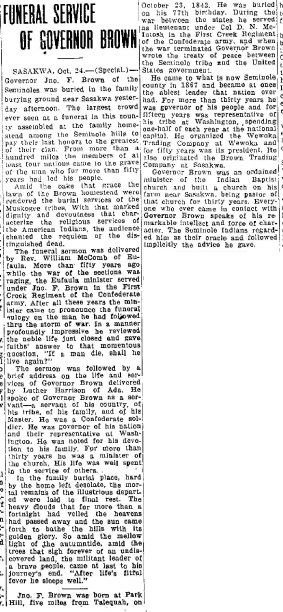|
Funeral Service of Governor
Brown
Sasakwa Oct. 24 --Special--
Gov. Jno. Brown of the Seminoles was
buried in the family burying ground near Sasakwa yesterday afternoon.
The largest crowd ever seen at a funeral in this county assembled at the family
homestead among the Seminole____ to pay their last honors to the greatest of their clan. From more than a
hundred miles the members of almost
four ____ came to the grave of the man who for more than fifty years led his
people.
Amid the ____ that grace the land of the
Brown homestead were _____ the burial services of the Mukogee Tribe.With that marked dignity and devoutness that characterize the religious services
of the American Indian, the Indians
chanted the requiem of the distinguished dead.
The funeral service was delivered by Rev.
William McComb of Eufaula. More than fifty years ago while the war of the
______ was raging, the Eufaula minister served under Jno. F. Brown in the First
Creek Regiment of the Confederate Army.
After all these years the minister came to pronounce the funeral eulogy of the
man he had followed through the storm of war.
In a manner profoundly impressive he reviewed the noble life just closed and
gave _____ answer to that momentous question
"If a man die, shall he live again?"
The sermon was followed by a brief
address on the life and services of Governor Brown delivered by Luther Harrison,
of Ada.
He spoke of Governor Brown as a servant _____ a servant of his country, of his
tribe, of his family, and of His Master. He was a
Confederate soldier. He was a governor to his people and their representative in
Washington. He was noted for his devotion to his
family. For more than thirty years he was a minister of the church. His life was
well spent in the service of others.
In the family burial place, hard by the
home left desolate, the mortal remains of the illustrious departed were laid in
final rest.
The heavy clouds that for more than a fortnight had veiled the heavens had
passed away and the sun came forth to bathe the hills
with its golden glory. So amid the mellow light of the autumntide, amid the
trees that sigh forever of an undiscovered land,the
militant leader of a brave people, came at last to his journey's end. "After
life's fitful fever, he sleeps well."
Jno. F. Brown was born at Park Hill, five
miles from Talequah on October 23, 1842. He was buried on his 77th birthday.
During the war between the states he served as lieutenant under Col. D. N.
McIntosh in the 1st Creek Regiment of the
Confederate Army, and when the war terminated Governor Brown wrote the treaty of
peace between the Seminole Tribe
and the United States government.
He came to what is now Seminole county in
1867 and became at once the ablest leader that nation ever had. For more than
thirty years he was governor of his people, and for fifteen years a
representative of his tribe at Washington, spending one half of
each year at the national capitol. He organized the Wewoka Trading Company at
Wewoka, and for fifty years was its president.
He also originated the Brown Trading Company at Sasakwa.
Governor Brown was an ordained minister
of the Indian Baptist Church, and built a church on his farm near Sasakwa being
a pastor of this church for thirty years. Everyone who ever came in contact with
Governor Brown speaks of his remarkable
intellect and force of character. The Seminole Indians regarded him as their
oracle and followed implicitly the advice he gave.


|